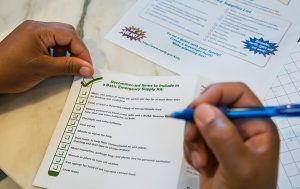 Are you ready? Are you prepared? Have you made a plan for your family in the event of an emergency?
Are you ready? Are you prepared? Have you made a plan for your family in the event of an emergency?
I would encourage you to take the time to put together a plan in case you have to evacuate your home due to an emergency. This is especially important in the case of a wildland fire. Planning and preparing ahead of time helps you to feel more calm than if you are rushing about trying to remember what to collect. It’s never too early to start preparing your family for an emergency.
Prepare
First of all, have you signed up for community alerts in your area; are you aware of the Emergency Alert System (EAS)? Being signed up allows you to receive text or email messages about emergencies from this system. It alerts you to pre-evacuation, evacuation, or shelter in place status in your area.
Family Communication Plan
How will your family members know what to do in the event of an emergency? All your family may not be together or at home when evacuation orders come. Have you completed a family communication plan? Who are your emergency out of town contacts that can help track family members? Have you identified potential evacuation routes? Take the time to put together an evacuation plan and pack an emergency preparedness kit for your family.
Emergency Preparedness Kit
An emergency preparedness kit is a collection of basic items needed in the event of an emergency. Consider the needs of your family and add supplies depending on those needs. Be sure to include water, food, any necessary medications, a change of clothes, spare chargers, and an extra set of credit cards, cash, or checks. If you can’t afford to stock up on supplies all at once, try slowly purchasing supplies a little each week.
At a minimum, consider including the basic supplies:
- Water: one gallon per person, per day (3-day supply for evacuation, 2-week supply for home)
- Food: non-perishable, easy-to-prepare items (3-day supply for evacuation, 2-week supply for home)
- Flashlight

- Battery-powered or hand-crank radio (NOAA Weather Radio, if possible)
- Extra batteries
- Deluxe family first aid kit
- Medications (7-day supply) and medical items
- Multi-purpose tool
- Sanitation and personal hygiene items, toothbrush and toothpaste, etc.
- Copies of personal documents (medication list and pertinent medical information, proof of address, deed/lease to home, passports, birth certificates, insurance policies)
- Cell phone with chargers
- Family and emergency contact information
- Extra cash
- Emergency blanket
- Map(s) of the area
House Pets and Outdoor Animals or Livestock
Have you included your house pets in your emergency preparation plans? Consider packing food and any medications for your pets(s) in your emergency preparedness kit. Your pets will be stressed too so having their same food to eat will be beneficial. Furthermore, ensure you have a plan for your outdoor animals or livestock as well.
Practice
 Every member of your family can prepare, even your children. Talk through your plan and practice. This helps ensure that all family members feel safe knowing what to do in the event of an emergency. Make sure everyone in the family knows your “safe” meeting place. Remember to let your friends and family know your plans. Where will you post the completed plans so that every member of your family is familiar with it?
Every member of your family can prepare, even your children. Talk through your plan and practice. This helps ensure that all family members feel safe knowing what to do in the event of an emergency. Make sure everyone in the family knows your “safe” meeting place. Remember to let your friends and family know your plans. Where will you post the completed plans so that every member of your family is familiar with it?
Pre-evacuation or Evacuation
When you receive the message for either pre-evacuation, start collecting and packing your To Go bags. Leaving early helps keep the roads clear so first responders are able to focus more on containing the emergency.
Evacuation requires leaving your home immediately and getting to a safe environment. Know what local procedures are during evacuation especially if you have pets and livestock. When an evacuation notice is issued, take prompt action to maximize safety for you and your family.
There are many ways to take action and prepare before a disaster occurs. Are you prepared?


Excellent reminders thanks.